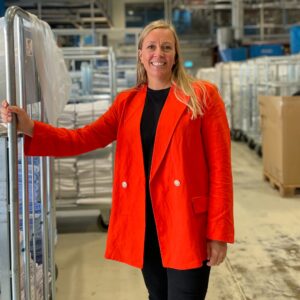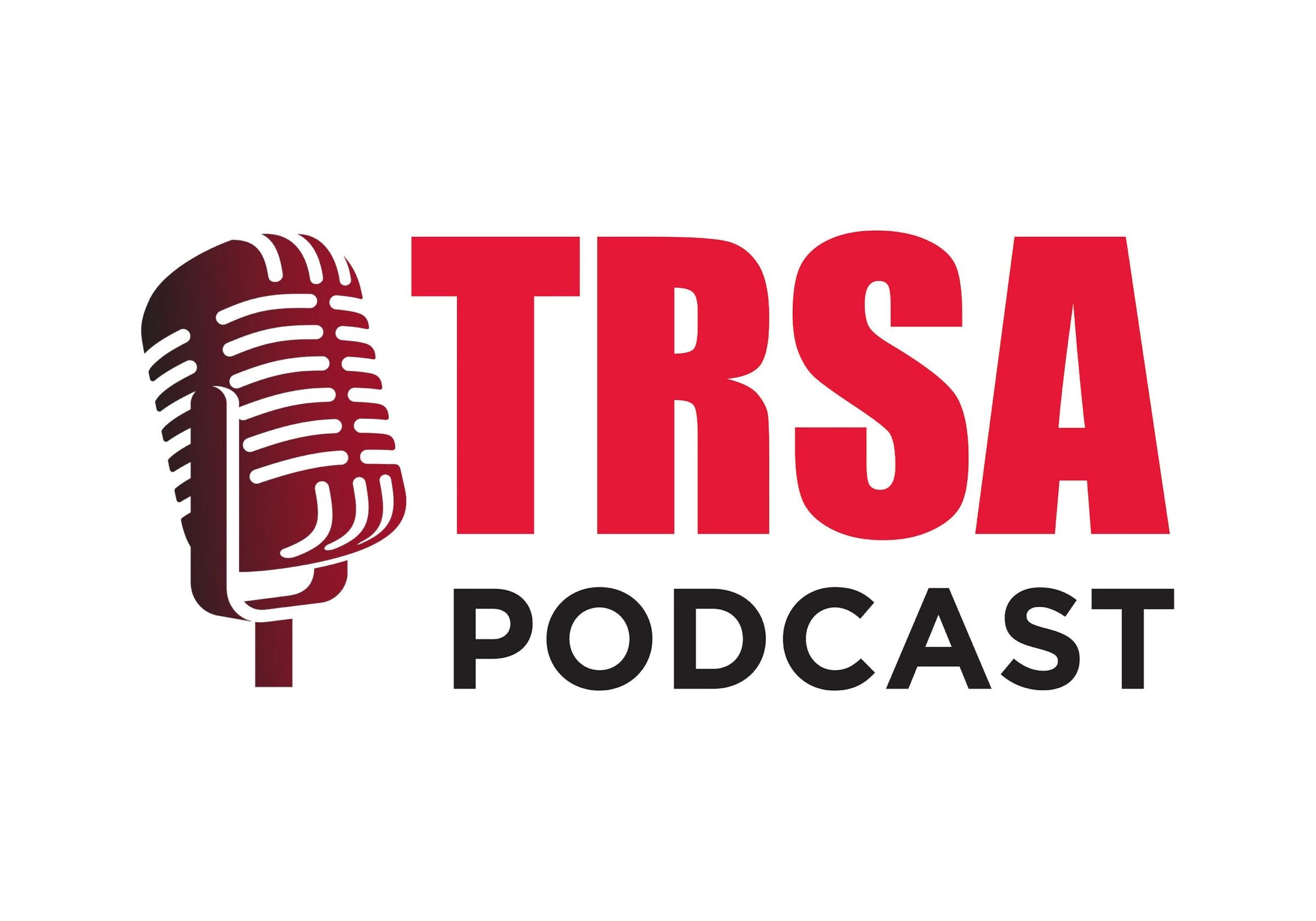 Silje Mari Sunde, project manager at Nor Tekstil, the market leader in Norway with 26 facilities and more than 1,300 employees, discusses how the company has increased automation in its facilities to boost the company’s efficiency and throughput. She outlines the benefits and challenges of automation, as well as how to ensure quality and consistency when implementing automation.
Silje Mari Sunde, project manager at Nor Tekstil, the market leader in Norway with 26 facilities and more than 1,300 employees, discusses how the company has increased automation in its facilities to boost the company’s efficiency and throughput. She outlines the benefits and challenges of automation, as well as how to ensure quality and consistency when implementing automation.
This Episode is Sponsored by:
Jason Risley: I’m Jason Risley, the host of TRSA’s Linen, Uniform and Facility Services Podcast. Special thanks to Jensen Group for sponsoring today’s episode. On this episode, we’ll discuss laundry automation with Silje Mari Sunde, the corporate manager of the project department at Nor Textil. Nor Textil is the market leader in Norway with more than 1,300 employees and annual revenues of nearly 145 million U.S. dollars. Nor Textil processes uniforms, hospitality and healthcare linen in its 26 laundry facilities across Norway and increasingly has turned to automation to increase the company’s efficiency and throughput.
Jason Risley: Well, thanks for joining me today. What were the key benefits of implementing automation in your laundry facilities?
Silje Mari Sunde: Well, thank you for inviting me. The key benefits, I can name several. But maybe the most important one and the first one that comes to mind is manpower.
It’s a scarcity. It’s hard to find stable personnel. So we find ourselves always recruiting, and that’s maybe the first driver to go for automation. Of course, there’s also cost involved, labor costs. We see that with automation, we can save overtime.
Maybe we can have fewer shifts at some plants. So it’s definitely a benefit that you save labor costs. But we also see that it improves the production flow. That’s an experience we have discovered after implementing it. Well, I’m talking about, specific sorting robots for soil side.
It really sets the tone in what is happening in the rest of the plant for the day. And we see with using automation, you get long series when you use sorting robots. So it improves the production flow with longer series, fewer shifts, and that’s a benefit for all of the plants also on the clean side. We see there are different, types of sorting the dirty linen with automation. You can use chips or RFID chips, or you can use cameras and artificial intelligence.
We see that when you use chips, you get almost 100% accuracy. So that’s a huge benefit. But not all of our plants have chips. Some use camera, and then you get, like, 95% accuracy. So it’s still quite high.
You don’t get the human errors. You get other errors, but not human errors. And also the safety of it. Sorting linen manually is heavy. It’s hot, it’s dirty, and it’s smelly, and it’s a huge benefit to have a robot do this instead of people.
People I’ve talked to who used to do this in plants that didn’t have automation before, they’re not missing this job. And closely connected to that is also injuries. There are risks when you are manually sorting textiles. In uniforms from hospitals, for example, there can be syringes, food and beverages, you can have glass.
Also, it’s a heavy job, so shoulders and back pain often come with the manual sorting. So I think, it takes down the risk for the personnel as well. And you have minimal interruption. The robot is going ahead with no toilet visits or no stops. It’s quite predictable.
So we see also all over, it’s a time saver. And we also have discovered one surprising thing. It seems like it’s prolonging the lifetime of the linen. We’re not sure quite why, but we see that less linens are scrapped. And we think maybe because of some of the textiles, they are scrapped based on subjective opinions with the people who touch it.
It seems that, the automation actually contributes to a longer lifetime for the linen. So that’s a few points.
Jason Risley: So it seems like there’s a lot of benefits to automating your facilities. How many facilities do you have?
Silje Mari Sunde: Nor Tekstil has 25 facilities in Norway. We have one far north up in Svalbard where we have ice bears. That’s the furthest north, and all the way to the south. So we are, across the entire country of Norway.
Jason Risley: Do you have this automated equipment in many of these facilities?
Silje Mari Sunde: So far, we have it installed in three different facilities, and there are more to come. We got our first one in late 2023, so not so many years ago. This was our biggest facility. It’s located in Oslo. It handles about 80 tons a day, and it’s an easy textile mix with mostly hotel linen.
So that was the first one we we got. And then we’ve got two new ones in 2024, and we are working on the fourth one, to come to a new facility that we are building in the city of Olesund right now, a really state-of-the-art, modern facility, supposed to break every record also when it comes to automation. So you should come and see that one. It should be ready in September, October this year. So that will be the biggest, automated, robot for sorting that we have so far.
And now we have a lot of learning too. So, this time, the installation will be very exciting.
Jason Risley: What types of automated systems do you currently use in your laundry facilities?
Silje Mari Sunde: I mentioned the sorting robots.
A lot of focus on that one. From the same vendor, Inwatec, we also have a high storage solution. This is a huge storage unit on the clean side, which is directly connected to the iron liners via conveyors. So the linen coming out of the iron liners in stacks are transported directly to the high storage where they are sorted and stored by category. And this really simplifies the packing process, as the packer can just scan the order for, a trolley, and then the high storage supplies the requested linen, so and so many sheets, so and so many duvet covers.
It spits it out, so, the packer just puts it directly onto the trolley. So this creates kind of a buffer between the iron liner and the packer. And so you don’t need employees standing at the end of every iron liner anymore to fetch the folded linen. So this is a robot we have in two facilities so far. And, we will have a third one for Olesund, which I mentioned new plants opening in September, October.
Jason Risley: And what are the initial costs and ongoing maintenance expenses associated with the automation in your facilities?
Silje Mari Sunde: There is, of course, an investment cost, depending very much on the size, from $1 to $3 million on the sizes we have now. And we do thorough calculation for the payback period for this, and it turns profitable, quite fast a few years down the line. So and that payback depends a lot on the saved manpower, the saved salary costs that come from automation. These robots that we have, they run on electricity, so there are some elevated electricity costs, of course, but nothing big to talk about.
And as, other laundry machines, it needs both preventive and ad hoc maintenance. We do educate our own technicians on the robots. So with a good spare part storage, we can fix most issues ourselves, the wearing parts. And also Inwatec, our provider of these machines, they have very good direct service. So they interact online with us for support.
We can ask questions. And also if there are some parts we are missing, they ship it to us immediately.
Jason Risley: So it sounds like they’re very helpful, Inwatec, if you have any maintenance issues that arise with the machinery.
Silje Mari Sunde: Really good experience with it. We are actually using WhatsApp for a really quick and direct connection between our technicians and their support.
Jason Risley: Technology has come such a long way, so it makes communicating easier.
Silje Mari Sunde: Yeah. You can film what a robot is doing and send pictures.
And so it works very well.
Jason Risley: Nice. And are there any potential challenges or risks of automating your laundry processes?
Silje Mari Sunde: Well, I started in Nor Tekstil two years ago as a project manager for group projects. And, automation was the one of the first projects I was handed.
This was the sorting robot I was talking about in our biggest plant. We were plowing new ground to some extent. And for innovative machines, there is also a risk that it won’t perform as expected when it comes to your environment. It depends on a lot of things, your customers, your linen, your production flow, the competence of your workers. So it’s not just plug and play.
It’s more complex than that. So we had to do some development and research work on the sorting robot after it was installed because the sorting quality was not where we needed it to be when it was sorting on camera and artificial intelligence. So we did a project on it. The goal was to lift the sorting quality to 95%. We found out that the source of the problem we had, was that all of the linen in this facility in Oslo that was producing 80 tons a day, it was mostly entirely wiped, and they’re not easy to separate from each other.
It was hard for the robots, I would say impossible for the human eye, to look at those pictures that was taken in a split of a second and then separated from another textile the way the algorithm worked then. So we had to do some work on the algorithm. We also did a rookie mistake when we were training the artificial intelligence. We were actually training it on clean linen instead of soiled linen. So it was performing well on the clean linen, but then when we got to real production linen that had red wine, coffee stains, the robot had never seen that before.
It didn’t really recognize it. So we had to redo some of the training. We also discovered other issues that were not related to the robots, like the way the sorted linen arrived to us in the facility from the hotels. In some cases, it was tumbled together as a ball containing duvet covers, sheets, pillowcases, sometimes tablecloth together in a ball. And when being sorted in the robot, the linen got double picked because the duvet covers were tangled up in the sheets.
So that was also a discovery. We have to work close to the customer to ask them to separate it better and not tumble it together in like a ball. But we also built an innovative new part for the robot that came out of this. We built a shaker, a new component, much like a tumbler, designed to crush these textile balls and separate the linen before it goes into the robot. And that worked.
So that was a huge victory. So, we find ourselves at the end of that project now, and we have reached the 95%. So it was a success. But I will say there are risks, of course. There are challenges.
You just have to face them and know that you can solve them. So I think there are more risks not doing automation. That’s my conclusion. Yeah.
Jason Risley: Were you able to make that part in house?
Silje Mari Sunde: No. We did it together with Inwatec and Jensen. It probably will be a part that’s commercially available for other facilities later.
We saved two employees shaking up the linen when we use this separator.
Jason Risley: So how does automation impact operational efficiency and cost savings at Nor Tekstil?
Silje Mari Sunde: Well, if I focus on the sorting robots, this has made a huge impact on the soil side.
As I said, you save manpower. You can use employees to keep up on the clean side instead. And, also, this is a task that no one is missing that they used to have before. So in all plants where we have this robot, we have seen a much more efficient handling of the soiled linen. For example, when you change series on the robots, you are running hotel and then you want to change to health, for example, that takes time.
The bags have to be half the full bags have to empty and so on. So it can take 10 to 20 minutes regarding how many bags you have that have to be purged. So, therefore, the discipline to run longer series before changing is stronger. The operator doesn’t want to change series unnecessary, and that has a huge impact on the overall effectiveness of the facility, also on the clean side, as I mentioned before. And so the robot needs one to maybe two operators, whereas the sorting platform needed earlier, maybe six to eight employees.
That’s very much more efficient now. Also, I didn’t mention that the sorting robot has X-ray technology. So where the employees on the sorting platform earlier had to check every pocket of a health worker uniform or a hotel bathrobe, the robot now spits out all garment that has items in the pockets, and that’s the only one you check. So, that is a huge time saver. Also, it saves textiles.
As I mentioned before, we see we have less scrapped textiles. It’s probably because we get out all the items, the forgotten items in pockets that later hurt the textile in the process.
Jason Risley: That’s interesting that increases the life of your textiles. When you were first implementing the new machinery, did you expect that to happen, or was that something that you discovered after implementing the machinery in your facilities?
Silje Mari Sunde: That’s more of a discovery we’ve done afterwards.
Yeah. That’s a great benefit. One with textile scrap textile being a huge problem worldwide. Oh, for sure. Right.
Jason Risley: Yeah. Much more environmentally friendly it is to have a longer life on those textiles. That’s important. So you talked about this earlier, but how do you ensure the quality and consistency of your laundry services when you’re implementing automation and this type of machinery?
Silje Mari Sunde: Yeah. We’ve gotten some experience in it now. And for the next robot installment, I will be working on the project, planning it in detail. And I will also have with me an operator that really knows the robot well from another plant, and he knows laundry very well.
So we will work as a team to make sure that this goes as planned. But so I think first of all, we prepare very well before we do an installation. We have learned from our earlier mistakes and, built some experience on how we best do this. If you talk about quality, we’ve also experienced, low quality in sorting from a robot, and we now know how to fix that. We’ve done that as well.
And clean side will let you know immediately if there is mixed linen. You will know. So we now know how to fix that. And to quantify the sorting quality, we’ve worked a lot about, with that. We do random tests.
After the robot has sorted a bag, we purge the bag, and we actually count the misplaced items. So we have statistics. It’s a manual job to count it. You have to do it. But then you have to test the statistics.
And then you can also go back, look at the pictures in the robot, try to find out why the robot misplaced this particular item. Did it look like something else? And find mistakes and then eliminate them. You can review the images in the machine itself once you find that it’s making an error.
And you have, for example, sheets that they are completely white, all of them, but some of them have a red thread or a blue thread or yellow thread indicating the size of it. And then you can find the sheets together with the duvet cases. Why is it there? And then you can look at the picture and see that this thread was not visible in the picture. So it looked very much like just a white duvet cover.
Yeah. So then it’s not much you can do. But, some sorting mistakes, you will have. But I think, I feel strongly about the facility and the plant itself. The manager of the plant, the operator of the machine, they really have to care for their machine.
They have to get to know it and love it and take care of it. So if you have a technician or operator that is owning the robot, taking care of it, following up closely, it will recognize any unusual behavior and take it early on. So we are working a lot with that as well. So and I think for us, we use, sorting robots, and we have a lot of steps in the laundry process automated. But we still have plenty of human touch with the textiles still, like from some of the iron liners and the packing.
And those are areas for quality check and also feedback if the linen looks, it’s in good shape. If it’s not, you will be told. So I don’t see that as a problem.
Jason Risley: So there’s still a personal touch with maintaining the machine and then also, as far as your staff, how does automation affect the workforce, and what training is required for your staff to interact with the machinery in place?
Silje Mari Sunde: As mentioned earlier, none of the employees spending hours on this task, maybe the whole day sorting on a platform, they are not missing this work.
So a hard and risky job is eliminated. So I will say that for those people, they have an improved work day. They’ve gotten new tasks.
Jason Risley: They’ve moved them to other areas of your laundry facility.
Silje Mari Sunde: Yes. They have. Some of them are still on soil side, but we have also moved people to clean side. And important to mark as well, there have been no layoffs because of automation at Nor Tekstil. And over time, we see that we produce more with fewer employees, which is increasing the profitability. So because the biggest cost we have is labor cost.
So there have been no layoffs, but it has taken the pressure off recruiting new employees for the ones who leave.
Jason Risley: Is there a difficult labor market in Norway?
Silje Mari Sunde: It definitely is. Production workers are hard to come by and hard to find. So, and also, we want workers who stay there for a while, who stay with us long.
I think, training for staff, also management when it comes to operating automation in a facility, that is the key. But I think all training is important and to give knowledge to the production workers as well. It’s important for Nor Tekstil. We have education and courses that we have developed ourselves that we offer to our employees, from, that has to do with chemistry, that has to do with all the things you need to work in a laundry facility. And that’s something that gives pride to the work, and, people want to stay there longer.
But, also, when you introduce automation in a laundry facility, you have to give specific training for that as well. The technician really has to learn how to operate the machine, how to maintain it, and fix issues. And it takes time to know the machine. And, in the meantime, of course, the close connection with the vendor is important. And the sorting robot we have, that is operated with a touch screen.
And the operator have to get very familiar with with this and all the settings and all the messages that pops up. So the operators, they actually take part from installing and testing the robots and get more and more responsibility to be ready to handle the observation. And I made a funny observation about that with one of the robots we installed. That was during summertime, and we had a lot of young employees in there with their summer jobs. They have strong digital instincts.
They grew up with iPads and the touch screens and much other technology. So they are very comfortable pushing buttons and experimenting in the settings. And, we saw a big difference there with our older, more experienced production managers. They tended to be be much more careful and skeptical of pushing the buttons. They wanted to be exactly sure what could happen if they pushed anywhere.
So, it was a funny observation. But the young employees, they really loved the the summer job working with that robot. They fight to be the one to operate it.
Jason Risley: How do your automated systems integrate with your existing laundry management software?
Silje Mari Sunde: In Nor Tekstil, we have built our own source system for laundry. We have had our own IT department since 2018 that’s maintaining and developing it. So that’s a huge benefit. And we see also that the new newest automated systems that we are purchasing, they are easier to build interfaces between our source system and these new systems.
So that has not been an issue. The data systems are more modern, and they are developed to allow integration in a different way. So for the sorting robot, for example, for every chip that the sorting robot reads, it does a lookup in Nor Tekstil’s own chip database to validate it, and then it gets the signal back what kind of, sorting category this item is. So it works very smoothly. And that also gives us a lot of, interesting information.
We will then know, that this specific garment is now back or linen is now back to the laundry from the customer sites. We can see how long has it been at the customer site. We can use this information also to see how many garments or linen pieces have been received, washed, from the chip. Week, month, year. So it gives us valuable data that we can use to predict, maybe for a customer, how much will they need next week, next month, next year.
It gives data that comes out of this is very valuable. And if you talk about automation, maybe the next level then is to automate the customer orders. But that depends on the chip. You cannot do that with the camera and artificial intel intelligence, sorting. You can do that with the chip sorting.
Jason Risley: So it’s all through the RFID chips.
Silje Mari Sunde: Yeah. But it’s very, intervening all of these new, innovations coming into the laundry industry. It works very well together.
Jason Risley: Have your customers asked for it? Do they ask for that data?
Silje Mari Sunde: Some of them do. It’s mostly us asking customers to get data from them.
But we are doing piloting already on automated customer orders for some customers. We can do that in areas and facilities where we have fully chipped collections of linen. So we are starting that journey early on, and it’s working so far.
Jason Risley: On that note, what future advancements and automation do you foresee for your laundry facilities?
Silje Mari Sunde: In Nor Tekstil, we are currently expanding. We are building new plants every year, and we’ll continue to do so as it seems. And we will also upgrade existing plants. And I think the automation follows, in building new facilities.
You are buying new equipment, so you check what’s new out there. The next one will always be the best one when it comes to every aspect of it. So I think that we will see fully chipped textile collection. Maybe in the five year future, maybe 10. It’s expensive.
It’s a huge investment to chip your textiles. But we really want to get that overview of what happens with the textiles, both in the facility and as we deliver it to customers. It has to do with distribution and everything. So there’s a lot of automation possibilities following the chip, like customer orders. We can use the data to predict what they need for the next order.
That’s the dream. Also, there are more automation similar to the sorting robot and the high storage that I talked about. There are some interesting towel folders on the market that looks promising as well. We don’t have any of those yet, but we are looking at it.
Jason Risley: When does that new plant come online? You said October?
Silje Mari Sunde: Yes. October. That’s the plan, and it’s following the plan so far. I’m the project manager there, so I’m following it closely.
Jason Risley: Yeah. That’ll be exciting.
Thanks again to Jensen Group for sponsoring today’s episode. If you’re interested in sponsoring a future episode of TRSA’s Linen, Uniform and Facility Services Podcast, email podcasts@trsa.org.
That’s podcasts@trsa.org. We’ll be back soon with more episodes of the show. In the meantime, make sure you subscribe, rate and review us on Apple iTunes. Additionally, follow TRSA across social media on Facebook, Instagram and LinkedIn.
Sign Up For Our Newsletter
Receive the latest updates on the linen, uniform and facility services industry from TRSA delivered straight to your inbox.










